The Surrounding Area
Rome
 A direct 35 minute train ride from the rail hub at Orte takes you into the heart of the Eternal City, easily accessible for a day trip or even just for an afternoon or evening. From Termini station simply jump on the number 40 bus to begin exploring central Rome. A city renowned for its world famous sights such as the Coliseum, Vatican, Trevi Fountain and Spanish Steps, Rome needs little introduction, however there is so much more to this fascinating city. In amongst the great central monuments discover Rome’s hidden gems by venturing off the beaten track. At sunset visit the atmospheric pocket sized Orange Garden on the Aventine hill, with its breath taking views over the Tiber and St Peter’s Dome. Here on Piazza dei Cavalieri di Malta you will also find the ‘Aventine Keyhole’ on the priory’s great door which offers the perfect view of St Peter’s Basilica standing majestically at the end of a tree lined avenue. Take refuge from Rome’s chaotic charm in one of the city’s many parks, walk to the Villa Borghese Gardens and art galleries from the top of the Spanish Steps, while taking in fantastic views over the city, the gardens extend from Piazza del Popolo to the top of Via Veneto. Just off Via Veneto is the fascinating and relatively undiscovered small church of Santa Maria delle Concezione which houses artist, Guido Reni’s painting of the Archangel Michael, however the church is best known for its crypts of the Capuchin friars. This monumental cemetery holds the skulls and bones, arranged in elaborate designs, of 4000 friars dating from 1500-1870.
A direct 35 minute train ride from the rail hub at Orte takes you into the heart of the Eternal City, easily accessible for a day trip or even just for an afternoon or evening. From Termini station simply jump on the number 40 bus to begin exploring central Rome. A city renowned for its world famous sights such as the Coliseum, Vatican, Trevi Fountain and Spanish Steps, Rome needs little introduction, however there is so much more to this fascinating city. In amongst the great central monuments discover Rome’s hidden gems by venturing off the beaten track. At sunset visit the atmospheric pocket sized Orange Garden on the Aventine hill, with its breath taking views over the Tiber and St Peter’s Dome. Here on Piazza dei Cavalieri di Malta you will also find the ‘Aventine Keyhole’ on the priory’s great door which offers the perfect view of St Peter’s Basilica standing majestically at the end of a tree lined avenue. Take refuge from Rome’s chaotic charm in one of the city’s many parks, walk to the Villa Borghese Gardens and art galleries from the top of the Spanish Steps, while taking in fantastic views over the city, the gardens extend from Piazza del Popolo to the top of Via Veneto. Just off Via Veneto is the fascinating and relatively undiscovered small church of Santa Maria delle Concezione which houses artist, Guido Reni’s painting of the Archangel Michael, however the church is best known for its crypts of the Capuchin friars. This monumental cemetery holds the skulls and bones, arranged in elaborate designs, of 4000 friars dating from 1500-1870.
Stop off to have the best coffee in Rome at Caffe’Eustachio, between the Pantheon and Piazza Novona or try an Italian iced granita, a dessert and caffeine fix in one. Also near the Pantheon sample the, not so secret, delicious Ice cream at Giolitti. Venture to the nearby small vibrant neighbourhoods of San Lorenzo, a haven for young and carefree artists and Rione Monti which is now one of the city’s hippest and most interesting areas, a stones’ throw from the Coliseum. Browse the city’s markets from Porta Portese’s flea market, which is among one of the best in Rome to Campo de Fiori’s morning flower market. From here take a stroll over The Tibre, towards Trastevere, and walk along the banks of the river past endless market stalls on long summer evenings. No trip to Rome is complete without a visit to the former working class district and heart of the city, the beautiful medieval area of Trastevere. Beat the crowds by exploring this area’s atmospheric narrow streets, churches, superb restaurants, galleries and trendy bars. Then take in magnificent views over the city from Gianicolo Hill rising above Trastevere.
Lake Bracciano
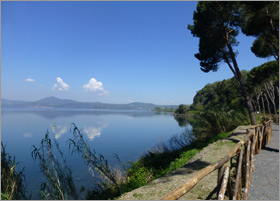 In under an hours’ drive from Tuscia, heading south towards Rome, is Lazio’s second largest lake, Bracciano. This beautiful lake with stunning views is bordered by three towns, Trevignano Romano, Anguillara Sabazia and Bracciano. Trevignano, located on Bracciano’s northern shore is the lake’s main sailing centre. This pretty town offers pleasant lakeside walks and a charming old town which is dominated by the Orsini Castle ruins high up on the hill. Anguillara’s medieval centre, on Bracciano’s southern shore is built on a small cape which juts out into the lake. The untouched old town is a quiet collection of cobblestone streets, which pass through the towns’ main gate and clock tower then climb up to the parish church where stunning views open out onto the lake. Bracciano, the lake’s namesake, is dominated by its well preserved 15th Century Castle Orsini-Odescalchi, which is renowned for hosting world famous events. Positioned high up on a hill, on the lakes western shore, the town’s medieval streets and tightly packed houses look out onto stunning views of the lake.
In under an hours’ drive from Tuscia, heading south towards Rome, is Lazio’s second largest lake, Bracciano. This beautiful lake with stunning views is bordered by three towns, Trevignano Romano, Anguillara Sabazia and Bracciano. Trevignano, located on Bracciano’s northern shore is the lake’s main sailing centre. This pretty town offers pleasant lakeside walks and a charming old town which is dominated by the Orsini Castle ruins high up on the hill. Anguillara’s medieval centre, on Bracciano’s southern shore is built on a small cape which juts out into the lake. The untouched old town is a quiet collection of cobblestone streets, which pass through the towns’ main gate and clock tower then climb up to the parish church where stunning views open out onto the lake. Bracciano, the lake’s namesake, is dominated by its well preserved 15th Century Castle Orsini-Odescalchi, which is renowned for hosting world famous events. Positioned high up on a hill, on the lakes western shore, the town’s medieval streets and tightly packed houses look out onto stunning views of the lake.
Orvieto
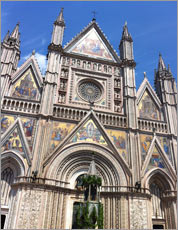 The majestic city of Orvieto, located within south western Umbria, allows for an easy 30 minute drive from central Tuscia. This beautiful town sprawls out across a cliff top, accessible by a funicular and a system of escalators and is set within breath taking scenery. Well known for its Gothic Cathedral, Ceramics and Classico wine, Orvieto experiences a high number of tourists throughout the summer months. The original 14th Century Romanesque Duomo with its nave and two side aisles was later transformed with added Gothic features into one of Italy’s liveliest facades, gleaming with golden mosaics, reliefs and stained glass. The town’s foundations also house a mass of Etruscan and medieval underground tunnels and caves, which are able to be explored by guided tours.
The majestic city of Orvieto, located within south western Umbria, allows for an easy 30 minute drive from central Tuscia. This beautiful town sprawls out across a cliff top, accessible by a funicular and a system of escalators and is set within breath taking scenery. Well known for its Gothic Cathedral, Ceramics and Classico wine, Orvieto experiences a high number of tourists throughout the summer months. The original 14th Century Romanesque Duomo with its nave and two side aisles was later transformed with added Gothic features into one of Italy’s liveliest facades, gleaming with golden mosaics, reliefs and stained glass. The town’s foundations also house a mass of Etruscan and medieval underground tunnels and caves, which are able to be explored by guided tours.
Norcia
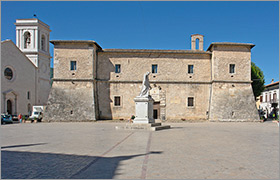 The pretty 13th Century walled town of Norcia is set in the heart of the Valnerina on the edge of the Sibillini National Park in southern Umbria. The largest town of the Nera Valley, Norcia is located in the province of Perugia and set within a wide plain encircled by mountains. World famous for its wild boar, pork products and truffles, every other shop in the town is a Norcineria, which is the Italian world for butchers specialising in pork goods and so named after the town. Sites not to be missed when visiting Norcia are the Church of St. Benedetto on Piazza San Benedetto, which is built in the shape of a cross and houses precious frescoes and paintings dating back to the 16th and 17th century. Another impressive example of Renaissance architecture is the Castellina, a four-sided strong-hold built by Vignola which is now the Municipal Diocesan Museum.
The pretty 13th Century walled town of Norcia is set in the heart of the Valnerina on the edge of the Sibillini National Park in southern Umbria. The largest town of the Nera Valley, Norcia is located in the province of Perugia and set within a wide plain encircled by mountains. World famous for its wild boar, pork products and truffles, every other shop in the town is a Norcineria, which is the Italian world for butchers specialising in pork goods and so named after the town. Sites not to be missed when visiting Norcia are the Church of St. Benedetto on Piazza San Benedetto, which is built in the shape of a cross and houses precious frescoes and paintings dating back to the 16th and 17th century. Another impressive example of Renaissance architecture is the Castellina, a four-sided strong-hold built by Vignola which is now the Municipal Diocesan Museum.
Cascata delle Marmore (Mamore Falls)
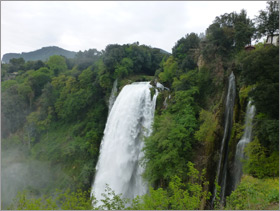 Created by the ancient Romans, Cascata delle Marmore is the tallest man made waterfall in the world. Set high up within an area of stunning natural beauty, close to the town of Terni in southern Umbria. The waterfall is divided into 3 sections with its upper section standing at 83 meters. A woodland path runs down along the falls allowing its visitors to hike to the bottom where the rushing water pours into the River Nera, forming the valley below. An entrance fee is charged to visit the falls and the surrounding area. It is worth noting that each day the flow is turned on and off according to a published schedule, when the water in the canals is diverted to a local power plant. To experience Marmore’s powerful full flow it is best to check when the fall gates are opened.
Created by the ancient Romans, Cascata delle Marmore is the tallest man made waterfall in the world. Set high up within an area of stunning natural beauty, close to the town of Terni in southern Umbria. The waterfall is divided into 3 sections with its upper section standing at 83 meters. A woodland path runs down along the falls allowing its visitors to hike to the bottom where the rushing water pours into the River Nera, forming the valley below. An entrance fee is charged to visit the falls and the surrounding area. It is worth noting that each day the flow is turned on and off according to a published schedule, when the water in the canals is diverted to a local power plant. To experience Marmore’s powerful full flow it is best to check when the fall gates are opened.
Pitigliano
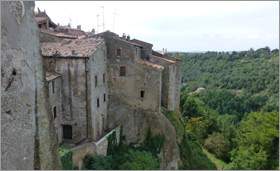 Carved out of this areas’ characteristic volcanic tufo, Pitigliano’s dramatic location perched atop a ridge and surrounded by green valleys’ makes for a fairy tale location. Situated in southern Tuscany’s Maremma, 25km west of Tuscia’s Lake Bolsena, Pitigliano is famous for its Etruscan tombs, embedded within the cliff face and valley, its picturesque medieval town centre and its highly regarded white wine. However the town is most renowned for being known as Little Jerusalem, for there has always been an historical presence of a Jewish community well integrated in its society. The Jewish quarter of the town was settled in the 16th Century when the town became a haven for Jews escaping the enclosed ghettos of cities such as Siena and Florence. Pitigliano was particularly attractive due to its close proximity to Rome and because of the laid back social policies of the aristocratic Orsini family, who ruled this area in the Renaissance period. Protected by the Orsini family the Jewish community thus flourished.
Carved out of this areas’ characteristic volcanic tufo, Pitigliano’s dramatic location perched atop a ridge and surrounded by green valleys’ makes for a fairy tale location. Situated in southern Tuscany’s Maremma, 25km west of Tuscia’s Lake Bolsena, Pitigliano is famous for its Etruscan tombs, embedded within the cliff face and valley, its picturesque medieval town centre and its highly regarded white wine. However the town is most renowned for being known as Little Jerusalem, for there has always been an historical presence of a Jewish community well integrated in its society. The Jewish quarter of the town was settled in the 16th Century when the town became a haven for Jews escaping the enclosed ghettos of cities such as Siena and Florence. Pitigliano was particularly attractive due to its close proximity to Rome and because of the laid back social policies of the aristocratic Orsini family, who ruled this area in the Renaissance period. Protected by the Orsini family the Jewish community thus flourished.
Il Giardino dei Tarocchi / The Tarot Garden
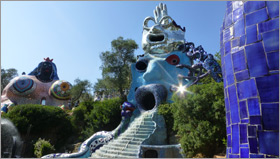 This colourful and impressive sculpture garden, created by artist Niki de Saint Phalle, which opened in 1998, is based on the twenty two monumental figures representing the major Arcana of the Tarot cards, one of the artist’s greatest passions. Located within southern Tuscany and with views over to the Tyrrhenian Sea, the parks beautiful setting is a monument to Saint Phalle’s wish to express ‘a small Eden where man and woman and nature meet’. The sculptures are both suggestive and evocative representing cards such as the Devil, Sun, Grand Empress and Emperor. Each one is built using concrete and steel then embellished with mirrors, coloured glass and ceramics creating a magical garden, clearly inspired by Antonio Gaudi’s Parc Guell in Barcellona and by the nearby Park of Monsters in Bomarzo.
This colourful and impressive sculpture garden, created by artist Niki de Saint Phalle, which opened in 1998, is based on the twenty two monumental figures representing the major Arcana of the Tarot cards, one of the artist’s greatest passions. Located within southern Tuscany and with views over to the Tyrrhenian Sea, the parks beautiful setting is a monument to Saint Phalle’s wish to express ‘a small Eden where man and woman and nature meet’. The sculptures are both suggestive and evocative representing cards such as the Devil, Sun, Grand Empress and Emperor. Each one is built using concrete and steel then embellished with mirrors, coloured glass and ceramics creating a magical garden, clearly inspired by Antonio Gaudi’s Parc Guell in Barcellona and by the nearby Park of Monsters in Bomarzo.
The Etruscan Coastline
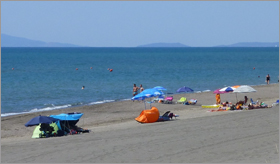 Tuscia’s unspoilt 85km coastline runs the full length of northern Lazio and is dotted with an array of different beaches, ranging from small secluded rocky shorelines to large solitary stretches of sand backed by vast dunes and large pine forests. Less than an hours’ drive from Viterbo visitors can choose between the larger resorts with a wide range of establishments or discover excellent local restaurants on the most secluded of beaches.
Tuscia’s unspoilt 85km coastline runs the full length of northern Lazio and is dotted with an array of different beaches, ranging from small secluded rocky shorelines to large solitary stretches of sand backed by vast dunes and large pine forests. Less than an hours’ drive from Viterbo visitors can choose between the larger resorts with a wide range of establishments or discover excellent local restaurants on the most secluded of beaches.
To the north of the province of Viterbo’s coastline is the seaside town of Marina di Pescia Romana which features both private and public beaches. Driving south near to Montalto di Castro, is the resort of Montalto Marina located near the mouth of the River Nera. Riva dei Tarquini’s wide sandy stretch of beach backed and protected by a large pine forest, is one of the area’s most naturalistic and beautiful beaches. Here you can park your car in the shade of the pines and make use of facilities such as picnic tables and BBQs and spend entire days at the beach in true Italian style. Close to the Etruscan city of Tarquinia is Tarquinia Lido one of the many resorts that sprang up in the 1950s. Sant’Agostino Marina is a peaceful stretch of beach which is enclosed by a small rocky point. The area of Santa Marinella and Santa Severa to the south of Civitavecchia, are well known resorts and ideal locations for windsurfing and surfing. Santa Severa houses the site of the ancient Greek-Etruscan port of Pyrgy, on its beach stands the Castle of Odescalchi just a short walk from the ruins of the port. Each one of these beaches and many others are all within easy access from central Tuscia and by way of Via Aurelia which runs the full length of Italy’s Tyrrhenian Coast.
Monte Argentario
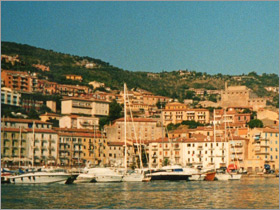 The Tuscan Peninsula of Monte Argentario is located just over the border from northern Lazio within easy access from Tuscia along Via Aurelia. This lush and mountainous peninsula is connected to the mainland by two strips of sand which form two lagoons. The two main towns are Porto Santo Stefano, to the north and Porto Ercole to the south. The larger sea port town of Santo Stefano has a lively harbour, with plenty of cafes and restaurants and attracts the worlds wealthy and elite. Heading west from Porto Santo Stefano a scenic road past Mediterranean shrub, olive groves and pines follows the jagged shoreline, hiding small bays, with stunning views across the coast to the Island of Giglio. The stylish smaller town of Porto Ercole, on the opposite side of the peninsula, has a picturesque waterfront by the marina and is also full of great restaurants, bars and boutiques.
The Tuscan Peninsula of Monte Argentario is located just over the border from northern Lazio within easy access from Tuscia along Via Aurelia. This lush and mountainous peninsula is connected to the mainland by two strips of sand which form two lagoons. The two main towns are Porto Santo Stefano, to the north and Porto Ercole to the south. The larger sea port town of Santo Stefano has a lively harbour, with plenty of cafes and restaurants and attracts the worlds wealthy and elite. Heading west from Porto Santo Stefano a scenic road past Mediterranean shrub, olive groves and pines follows the jagged shoreline, hiding small bays, with stunning views across the coast to the Island of Giglio. The stylish smaller town of Porto Ercole, on the opposite side of the peninsula, has a picturesque waterfront by the marina and is also full of great restaurants, bars and boutiques.
See more pictures of the cities, towns and lakes surrounding Tuscia >>
